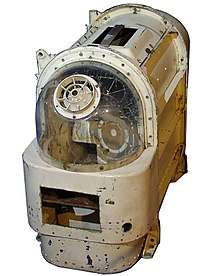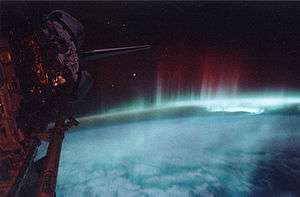Soviet space dogs
During the 1950s and 1960s the Soviet space program used dogs for sub-orbital and orbital space flights to determine whether human spaceflight was feasible. In this period, the Soviet Union launched missions with passenger slots for at least 57 dogs. The number of dogs in space is smaller, as some dogs flew more than once. Most survived; the few that died were lost mostly through technical failures, according to the parameters of the test.

| Part of a series of articles on the |
| Soviet space program |
|---|
 |
|
A notable exception is Laika, the first dog to be sent into orbit, whose death during the 3 November, 1957 Sputnik 2 mission was expected from its outset.[1]
Training
Dogs were the preferred animal for the experiments because scientists felt dogs were well suited to endure long periods of inactivity.[2] As part of their training, they were confined in small boxes for 15–20 days at a time. Stray dogs, rather than animals accustomed to living in a house, were chosen because the scientists felt they would be able to tolerate the rigorous and extreme stresses of space flight better than other dogs. Female dogs were used because of their temperament and because the suit the dogs wore in order to collect urine and feces was equipped with a special device, designed to work only with females.[3][4]
Their training included standing still for long periods of time, wearing space suits, being placed in simulators that acted like a rocket during launch, riding in centrifuges that simulated the high acceleration of a rocket launch and being kept in progressively smaller cages to prepare them for the confines of the space module. Dogs that flew in orbit were fed a nutritious jelly-like protein. This was high in fiber and assisted the dogs to eliminate during long periods of time while in their small space module. More than 60% of dogs to enter space were reportedly suffering from constipation and gallstones on arrival back to base.[5]
Sub-orbital flights
Dogs were flown to an altitude of 100 km (62 mi) on board 15 scientific flights on R-1 rockets from 1951 to 1956. The dogs wore pressure suits with acrylic glass bubble helmets. From 1957 to 1960, 11 flights with dogs were made on the R-2A series, which flew to about 200 km (120 mi). Three flights were made to an altitude of about 450 km (280 mi) on R-5A rockets in 1958. In the R-2 and R-5 rockets, the dogs were contained in a pressured cabin.[6]
Dezik, Tsygan, and Lisa
Dezik (Дезик) and Tsygan (Цыган, "Gypsy") were the first dogs to make a sub-orbital flight on 15 August 1951.[2] Both dogs were recovered unharmed after travelling to a maximum altitude of 110 km (68 mi). Dezik made another sub-orbital flight in 1951 with a dog named Lisa (Лиса, "Fox"), although neither survived because the parachute failed to deploy.[2] After the death of Dezik, Tsygan was adopted as a pet by Soviet physicist Anatoli Blagonravov.[7]
Lisa and Ryzhik
Lisa (Лиса, "Fox" or "Vixen") and Ryzhik (Рыжик, "Ginger" (red-haired)) flew to an altitude of 100 km (62 mi) on 2 June 1954.
Smelaya and Malyshka
Smelaya (Смелая, "Brave" or "Courageous") was due to make a flight in September but ran away the day before the launch. She was found the next day and went on to make a successful flight with a dog named Malyshka (Малышка, "Baby"). They both crashed after the rocket failed to deploy a parachute, and were found the next day by the recovery team.
Bobik and ZIB
Bobik (Бобик) ran away just days before his flight was scheduled to take place on 15 September 1951.[2] A replacement named ZIB (a Russian acronym for "Substitute for Missing Bobik", "Замена Исчезнувшему Бобику" Zamena Ischeznuvshemu Bobiku), who was an untrained street dog found running around the barracks, was quickly located and made a successful flight to 100km and back.[8][2]
Otvazhnaya and Snezhinka
Otvazhnaya (Отважная, "Brave One" (Female)) made a flight on 2 July 1959 along with a rabbit named Marfusha (Марфуша, "Little Martha") and another dog named Snezhinka (Снежинка, "Snowflake"). She went on to make 5 other flights between 1959 and 1960.[9]
Albina and Tsyganka
Albina (Альбина, a real female name) and Tsyganka (Цыганка, "Gypsy girl") were both ejected out of their capsule at an altitude of 85 km (53 mi) and landed safely. Albina was one of the dogs shortlisted for Sputnik 2, but never flew in orbit.
Damka and Krasavka
Damka (Дамка, "Queen of checkers") and Krasavka (Красавка, "Little Beauty") were to make an orbital flight on 22 December 1960 as a part of the Vostok programme which also included mice.[10] However their mission was marked by a string of equipment failures.
The upper-stage rocket failed and the craft re-entered the atmosphere after reaching a sub-orbital apogee of 214 km (133 mi). In the event of unscheduled return to the surface, the craft was to eject the dogs and self-destruct, but the ejection seat failed and the primary destruct mechanism shorted out. The animals were thus still in the intact capsule when it returned to the surface. The backup self-destruct mechanism was set to a 60-hour timer, so a team was quickly sent out to locate and recover the capsule.
Although the capsule was reached in deep snow on the first day, there was insufficient remaining daylight to disarm the self-destruct mechanism and open the capsule. The team could only report that the window was frosted over in the −43 °C (−45 °F) degree temperatures and no signs of life were detected. On the second day, however, the dogs were heard barking as the capsule was opened. The dogs were wrapped in sheepskin coats and flown to Moscow alive, though all the mice aboard the capsule were found dead because of the cold.[11]
Damka was also known as Shutka (Шутка, "Joke") or Zhemchuzhnaya (Жемчужная, "Pearly") and Krasavka was also known as Kometka (Кометка, "Little Comet") or Zhulka (Жулька, "Cheater"). After this incident Krasavka was adopted by Oleg Gazenko, a leading soviet scientist working with animals used in space flights. She went on to have puppies and continued living with Gazenko and his family until her death 14 years later.[10] After the incident Sergey Korolyov, who was the designer of the rocket, wanted to make the story public, but was prevented from doing so by state censorship.[12]
Bars and Lisichka
Bars (Барс (pron. "Barss" not "Barz"); "Snow leopard") and Lisichka (Лисичка, "Little Fox") were also on a mission to orbit as a part of the Vostok programme, but died after their rocket exploded 28.5 seconds into the launch on July 28, 1960.[2] Bars was also known as Chayka (Чайка, "Seagull").
Other dogs that flew on sub-orbital flights include Dymka (Дымка, "Smoky"), Modnitsa (Модница, "Fashionable") and Kozyavka (Козявка, "Little Gnat").
At least four other dogs flew in September 1951, and two or more were lost.
Orbital flights
Laika

Laika (Лайка, "Barker") became the first living Earth-born creature (other than microbes) in orbit, aboard Sputnik 2 on 3 November 1957.[2] Some call her the first living passenger to go into space, but many sub-orbital flights with animal passengers passed the edge of space first, for instance the rhesus macaque Albert II. She was also known as Zhuchka (Жучка, "Little Bug") and Limonchik (Лимончик, "Little Lemon"). The American media dubbed her "Muttnik", making a play-on-words for the canine follow-on to the first orbital mission, Sputnik. She died between five and seven hours into the flight from stress and overheating.[13] Her true cause of death was not made public until October 2002; officials previously gave reports that she died when the oxygen supply ran out.[9] At a Moscow press conference in 1998 Oleg Gazenko, a senior Soviet scientist involved in the project, stated "The more time passes, the more I'm sorry about it. We did not learn enough from the mission to justify the death of the dog...".[14]
Belka and Strelka


Belka (Белка, literally, "Squirrel" or alternatively "Whitey") and Strelka (Стрелка, "Little Arrow") spent a day in space aboard Korabl-Sputnik 2 (Sputnik 5) on 19 August 1960 before safely returning to Earth.[9]
They were accompanied by a grey rabbit, 42 mice, two rats, flies and several plants and fungi. All passengers survived. They were the first Earth-born creatures to go into orbit and return alive.[15]
Strelka went on to have six puppies with a male dog named Pushok who participated in many ground-based space experiments, but never made it into space.[16] One of the pups was named Pushinka (Пушинка, "Fluffy") and was presented to President John F. Kennedy by Nikita Khrushchev in 1961. A Cold War romance bloomed between Pushinka and a Kennedy dog named Charlie, resulting in the birth of four pups that JFK referred to jokingly as pupniks.[17] Two of their pups, Butterfly and Streaker, were given away to children in the Midwest. The other two puppies, White Tips and Blackie, stayed at the Kennedy home on Squaw Island but were eventually given away to family friends.[16] Pushinka's descendants were still living at least as of 2015[18] A photo of descendants of some of the Space Dogs is on display at the Zvezda Museum in Tomilino outside Moscow.[19]
A Russian animated feature film called Belka and Strelka: Star Dogs (English title: Space Dogs) was released in 2010.
Pchyolka and Mushka
Pchyolka (Пчёлка, "Little Bee") and Mushka (Мушка, "Little Fly") spent a day in orbit on 1 December 1960 on board Korabl-Sputnik-3 (Sputnik 6) with "other animals", plants and insects.[9] Due to a reentry error when the retrorockets failed to shut off when planned, their spacecraft was intentionally destroyed by remote self-destruct to prevent foreign powers from inspecting the capsule on 2 December and all died. Mushka was one of the three dogs trained for Sputnik 2 and was used during ground tests. She did not fly on Sputnik 2 because she refused to eat properly.
Chernushka
.jpg)
Chernushka (Чернушка, "Blackie") made one orbit on board Korabl-Sputnik-4 (Sputnik 9) on 9 March 1961[20] with a cosmonaut dummy (whom Soviet officials nicknamed Ivan Ivanovich), mice and a guinea pig. The dummy was ejected out of the capsule during re-entry and made a soft landing using a parachute. Chernushka was recovered unharmed inside the capsule.
Zvyozdochka
Zvyozdochka (Zvezdochka, Звёздочка, "Starlet"[21]), who was named by Yuri Gagarin, made one orbit on board Korabl-Sputnik 5 on 25 March 1961 with a wooden cosmonaut dummy in the final practice flight before Gagarin's historic flight on 12 April.[21] Again, the dummy was ejected out of the capsule while Zvezdochka remained inside. Both were recovered successfully.
Veterok and Ugolyok
Veterok (Ветерок, "Light Breeze") and Ugolyok (Уголёк, "Ember") were launched on 22 February 1966 on board Cosmos 110, and spent 21 days in orbit before landing on 16 March.[4] This spaceflight of record-breaking duration was not surpassed by humans until Soyuz 11 in June 1971 and still stands as the longest space flight by dogs.
See also
- Animals in space
- Cosmo (comics)
- Félicette: First cat in space
- List of individual dogs
- Monkeys and non-human apes in space
- the Museum of Jurassic Technology has an eternal flame dedicated to Laika and a portrait gallery of the USSR's space dogs
- Sputnik program
- Voskhod program
References
- Berger, Eric (3 November 2017). "The first creature in space was a dog. She died miserably 60 years ago". Ars Technica. Retrieved 3 November 2017.
- Gray, Tara (2 August 2004). "A Brief History of Animals in Space". NASA.
- Canine Nation (3 November 2002). A Few Facts about Russian Space Dogs Archived 8 January 2006 at the Wayback Machine via dogsinthenews.com.
- Chris Dubbs (2003) Space Dogs: Pioneers of Space Travel, iUniverse, ISBN 0-595-26735-1
- Chris Dubbs and Colin Burgess, Animals In Space: From Research Rockets to the Space Shuttle, Springer, 2007, ISBN 0387360530
- Ushakova, et al., Istoriya Otechestvennoi Kosmicheskoi Meditziny, Moskva-Voronezh, 2001.
- Asif Siddiqi, Sputnik and the Soviet Space Challenge, University Press of Florida, 2003, ISBN 081302627X, p. 96
- Lileks, James (1 November 2019). "Remembering Laika the space dog". StarTribune.
- DE Beischer and AR Fregly (1962). "Animals and man in space. A chronology and annotated bibliography through the year 1960". US Naval School of Aviation Medicine. ONR TR ACR-64 (AD0272581). Retrieved 14 June 2011.
- Kate Baklitskaya (1 May 2013) The remarkable (and censored) Siberian adventure of stray dog cosmonauts Comet and Shutka. Siberiantimes.com. Retrieved on 14 May 2013.
- John Rhea, Roads to Space: An Oral History of the Soviet Space Program, Aviation Week Group, 1995, ISBN 0076070956 pp. 197–199 and 415–417.
- Remarkable survival of Russian space dogs who plummeted 200km to Earth when rocket malfunctioned then spent four days in −40C Siberian wilderness. Dailymail.co.uk (4 May 2013). Retrieved on 14 May 2013.
- "First dog in space died within hours". BBC. 28 October 2002. Retrieved 4 January 2010.
- Dick Abadzis, afterword to Laika, First Second, 2007, ISBN 1-59643-302-7
- Georgiou, Aristos (3 November 2019). "Laika the dog: These are all the animals that have been launched into space". Newsweek.
- John F. Kennedy Presidential Library & Museum. Reference Desk: Pets. Accessed 8 July 2007
- Bark At the Moon: A Short History of Soviet Canine Cosmonauts From About.com Space / Astronomy. Accessed 8 July 2007
- Mosher, Dave. "I traveled to Russia and met the first dogs to ever survive space in this rare museum". Business Insider. Retrieved 29 October 2019.
- Dogs in Space: James M Skipper's visit to the NPO Zvezda Museum, The Skipper Family magazine. Accessed 7 July 2007
- Sputnik 9 and Chernushka (March 1961) on YouTube
- Asif A. Siddiqi (2000). Challenge to Apollo: The Soviet Union and the Space Race, 1945–1974. NASA. SP-2000-4408. Part 1 (page 1-500), Part 2 (page 501-1011). p. 267
External links
- A book chapter about biological experiments in geophysical rockets (in Russian)
- Space Today Online article about animals sent into space
- One Small Step: The Story of the Space Chimps, Official Documentary Site Documentary features rare footage of Laika and others.

